Science Centre: Crisp Packet Fireworks
Interview with
Ginny - There seems to be a lot of rubbish on this table. Have you just been eating, crisps? And what's with these plates? I don't think I'd want to eat my dinner off that.
Dave - Well, also on this table, I have a microwave.
Ginny - Yeah, I thought that was just for your dinner as well.
Dave - I get quite peckish, so this is understandable. So, the rubbish we have is a crisp packet and crisp packets are quite beautiful things. They're shiny on the inside and they kind of plasticky on the outside. What we have here is a microwave oven. Now, the way a microwave oven cooks is by essentially causing electric currents to flow backwards and forwards inside the food. Food isn't a very good conductor, so it doesn't get very hot. However, the shiny aluminium inside a crisp packet conducts electricity really quite well. Aluminium is almost as good a conductor as copper.
Ginny - Now, I've always been told not to put anything with metal on it in the microwave.
Dave - This might explain why. Probably, a crisp packet is the one thing that with permission isn't too bad in a microwave. But anything else with metal is a really, really bad idea. So, I'm going to open the microwave and I'm going to put the crisp packet into the back of the microwave. Hopefully, that should be standing up.
Ginny - Okay, so we've now got a crisp packet in a microwave and we probably want to put the house lights down around now so that people can see what's going on, and then you're going to turn on the microwave?
Dave - So I'll turn on the microwave, this should cause lots and lots of electric currents to flow inside the crisp packet and that might make it a bit warm.
Ginny - So, we got what looked like a whole load of sparks going out from inside the crisp packet. If there was just a current flowing through there, why did we get sparks?
Dave - So, first thing, I'm going to very, very carefully go in and because it could be very hot and take the crisp packet out.
Ginny - Okay, that doesn't look like it would be much use for holding, crisps anymore. It's all scrunched up. It's kind of melted into one blob. It doesn't look very appealing.
Dave - So, it has shrivelled up in the same way as if you put a crisp packet on a fire, it gets hot and it shrinks, and shrivels up. As it's doing that, it kind of bends and you get big electric currents flowing through it and all of a sudden, you can get bits getting close to each other. There's kind of a shortcut the electricity can take through the air and it jumps through the air and produces sparks. As it shrinks, the bubbles get close to each other. You get sparks and you get these rather exciting noises which I'm sure you heard.
Ginny - So, it's a little bit like lightning except it's jumping a much smaller distance than lightning does.
Dave - Exactly, right, yes.
Chris - Ginny and Dave, thank you very much. Anyone got any questions? We have one down the front here. What's your name, madam?
Joti - Hi. I'm Joti. I live in Cambridge. You can put food in the microwave on aluminium foil and it's absolutely fine. It heats up. So, how does that happen?
Dave - I think aluminium will get hot in a microwave if the microwaves can get to it, it will get hot. But if it can't shrink because with the crisp packet it was shrinking and you get the small gaps where the electricity can jump as sparks, you don't necessarily get sparking. You do get sparking off things like gold rims on plates because then you get a little break in the gold rim and then you get sparking across that. I wouldn't necessarily say it was a good idea in general, but I can quite believe that it works.
Ginny - So, you only really get sparks when you've got something that can conduct the electricity, but then a point where it can't conduct it anymore and it has to jump through the air. So, because the crisp packets have a sort of plasticky coating, that can't conduct the electricity anymore. So then, when the electricity reaches that point, it has to jump and that's why you get the sparks.
Chris - We have a question down the front here. What's your name?
Nathan - Nathan.
Chris - Hello, Nathan. What can we do for you?
Nathan - I was just wondering if you would be able to do that again.
Ginny - Dave is just going to set it up again. We're going to put the crisp packet back in the microwave and turn the house lights down, and then we'll set it going. There we go.
Chris - Okay, next question. Yes, sir, down the front here in the black t-shirt. What's your name?
Ashley - Ashley.
Chris - Hello, Ashley. What would you like to know?
Ashley - What will happen if you tried to cook food in a crisp packet like that?
Ginny - Well, as you saw, the crisp packet kind of shrivelled up and melted. So, I think what you would find is you'd have bits of melted crisp packet stuck to your food. It will probably also burn in places.
Dave - And hot plastic doesn't taste good, I've found from experience so I wouldn't recommend it.
Ginny - No, I don't think it will be the best way to cook your dinner.
Chris - Okay, there's one more question here. This gentleman just in the second row here. What's your name?
Aaron - Aaron.
Chris - Hello, Aaron.
Aaron - So, if it takes electricity 10,000 volts to jump a centimetre, how many volts were in that crisp packet when it's sparking?
Dave - There was certainly - there will have been thousands of volts. The electricity kind of sloshs backwards and forwards through the crisp packet. And as it does that when it kind of slams into one end, you get very, very high voltages.
Chris - Just over here, yes, sir.
Fergal - My name is Fergal. I know hot plastic doesn't taste good, but is there any health risk associated with cooking food in plastic dishes in a microwave?
Chris - Ready meals.
Ginny - So, yeah. I think the answer is that they do do tests on things like that. So, I think anything where your food sold in a plastic thing that says you can put it in a microwave, they would've tested that and they would've shown that the chemicals weren't going to harm you. If it's something that's not microwave safe then if it melts then you actually end up ingesting more of that plastic because it's melted into your food. That's probably not going to do you much good.
Dave - There are some plastics which when you get them hot, do give off bad chemicals but they would deliberately pick them not to use in food packaging. The really nasty thing about the hot plastic when it starts to burn, you get lots of nasty chemicals and hopefully, you're not burning your food too badly when you're cooking a ready meal.










Comments
Add a comment